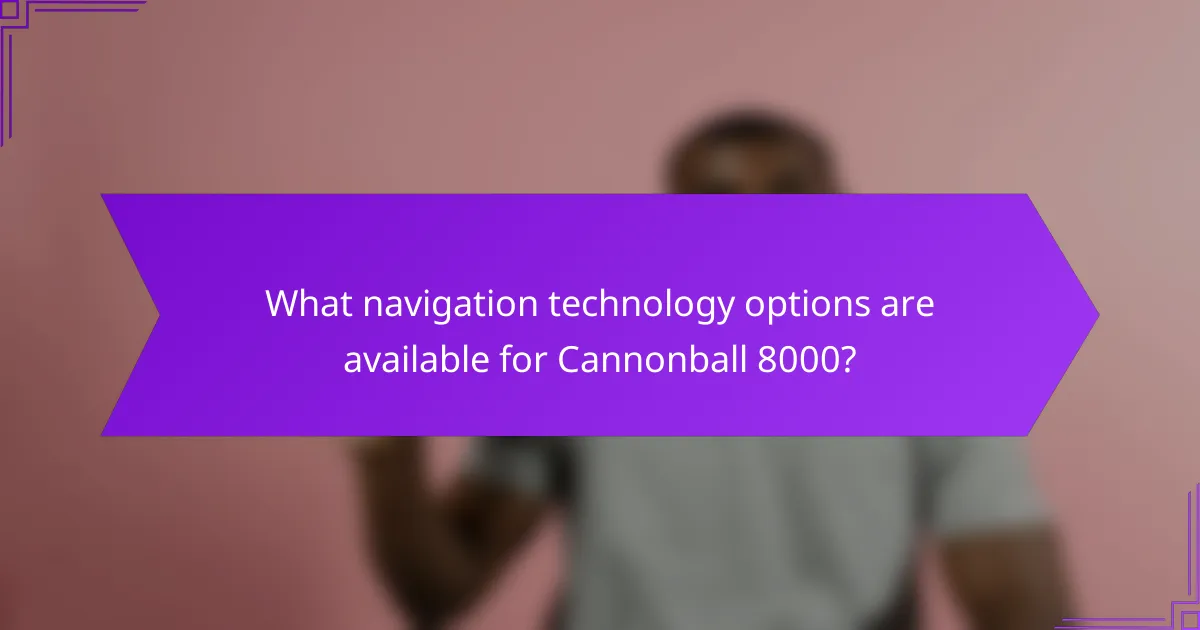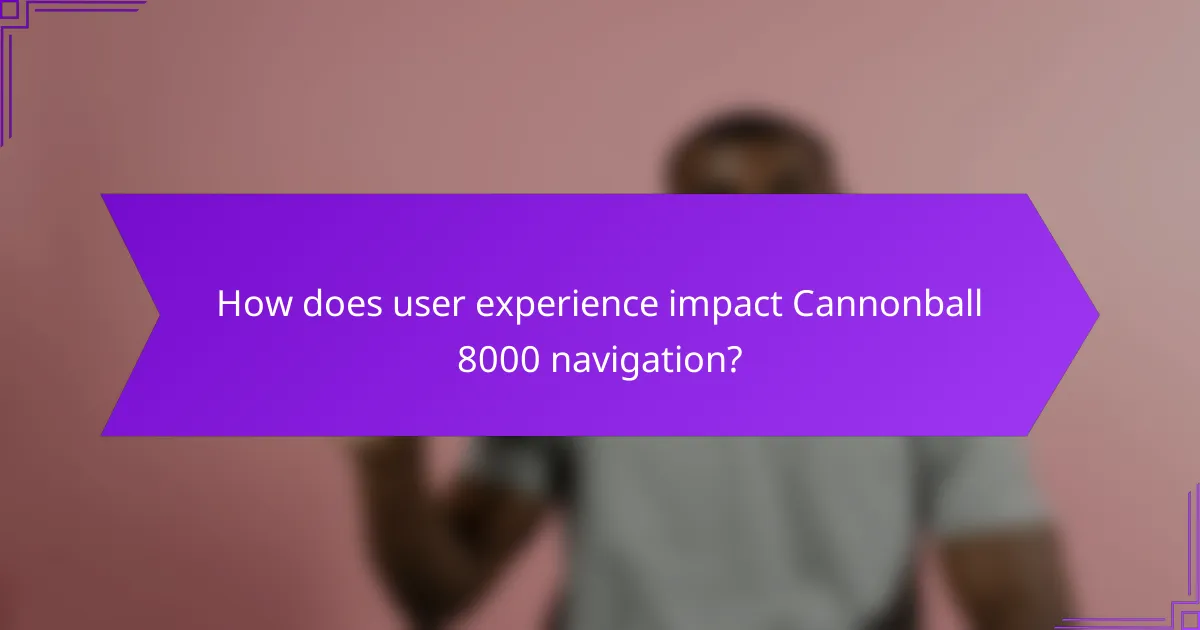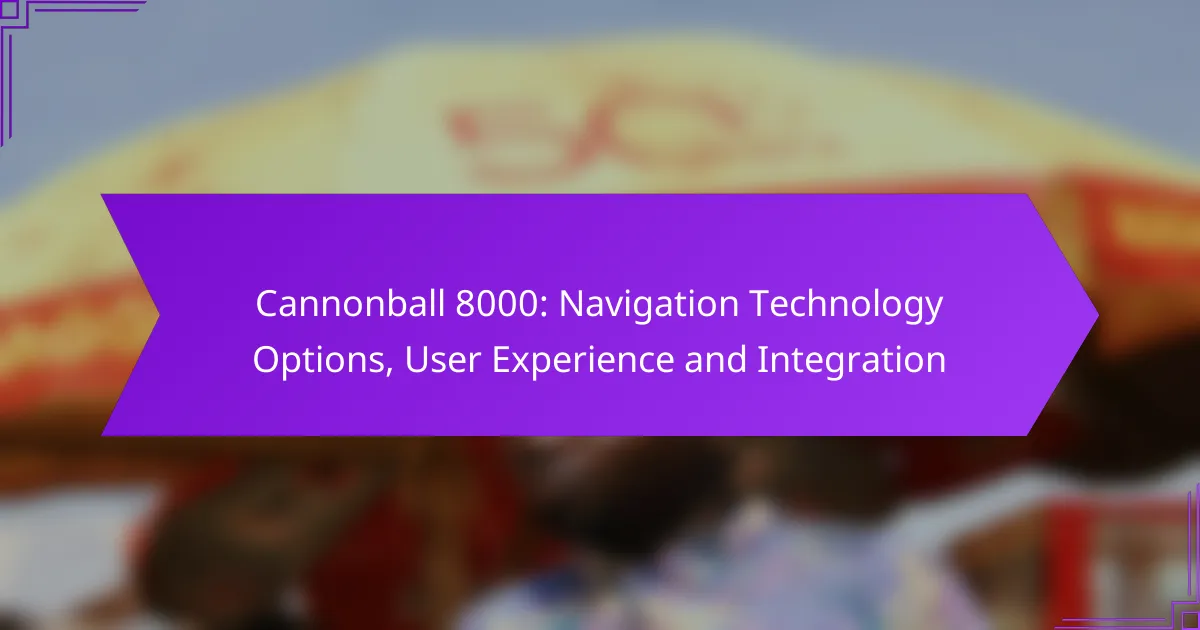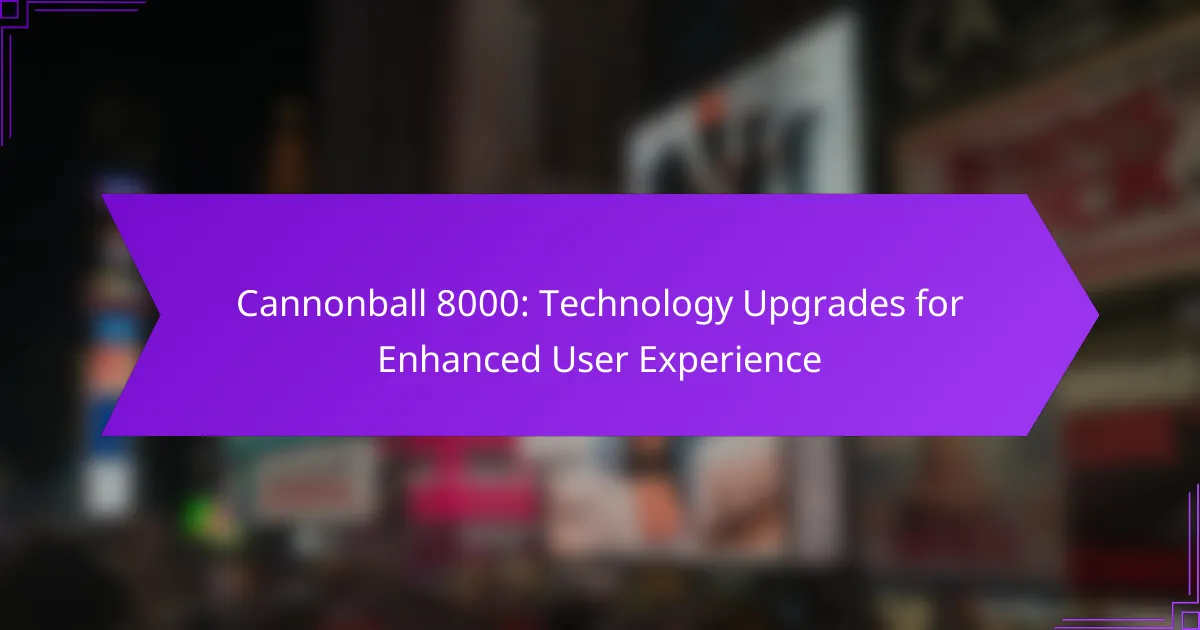The Cannonball 8000 features a diverse array of navigation technology options, including GPS, GLONASS, and augmented reality navigation, each designed to enhance user experience and integration. A well-crafted interface and responsive feedback mechanisms contribute to user satisfaction, making navigation safer and more enjoyable. Additionally, the system’s robust integration capabilities allow for seamless connectivity with various platforms, ensuring a smooth operational experience.

What navigation technology options are available for Cannonball 8000?
The Cannonball 8000 offers a variety of navigation technology options, including GPS, GLONASS, inertial navigation systems, RTK solutions, and augmented reality navigation. Each technology has unique features and benefits that enhance user experience and integration capabilities.
GPS Integration
GPS integration is a fundamental navigation technology for the Cannonball 8000, providing accurate positioning data globally. It operates by receiving signals from a network of satellites, allowing for location tracking within a few meters under optimal conditions.
When using GPS, consider factors such as satellite visibility and potential obstructions, which can affect accuracy. For best results, ensure that the device has a clear view of the sky, especially in urban environments or dense foliage.
GLONASS Compatibility
GLONASS compatibility enhances the Cannonball 8000’s navigation capabilities by utilizing Russia’s satellite system alongside GPS. This dual-system approach can improve positioning accuracy and reliability, especially in challenging environments.
Devices that support both GPS and GLONASS can achieve better performance in terms of speed and precision, often reducing location fix times. Users should verify if their Cannonball 8000 model supports this feature for optimal navigation.
Inertial Navigation Systems
Inertial navigation systems (INS) provide an alternative method for tracking movement by measuring acceleration and rotation. This technology is particularly useful when GPS signals are weak or unavailable, such as in tunnels or urban canyons.
INS can complement GPS and GLONASS by maintaining accurate positioning during brief signal losses. However, users should be aware that INS can drift over time, requiring periodic recalibration with external signals for sustained accuracy.
Real-Time Kinematic (RTK) Solutions
Real-Time Kinematic (RTK) solutions offer centimeter-level accuracy for the Cannonball 8000 by using a base station and a rover. This technology is ideal for applications requiring high precision, such as surveying or autonomous vehicle navigation.
RTK systems require a stable communication link between the base station and the rover, which can be affected by distance and environmental factors. Users should ensure they have the necessary equipment and setup to utilize RTK effectively.
Augmented Reality Navigation
Augmented reality (AR) navigation enhances the user experience by overlaying digital information onto the real world. For the Cannonball 8000, AR can provide visual cues and contextual information, improving situational awareness and navigation efficiency.
To implement AR navigation, users should ensure their device is equipped with the necessary sensors and software. This technology can significantly enhance navigation in complex environments, but it may require additional power and processing capabilities.

How does user experience impact Cannonball 8000 navigation?
User experience significantly influences how effectively the Cannonball 8000 navigation system operates. A well-designed interface, responsive feedback mechanisms, and ample customization options can enhance user satisfaction and efficiency, leading to safer and more enjoyable navigation.
User Interface Design
The user interface (UI) of the Cannonball 8000 is crucial for ease of navigation. A clear layout with intuitive icons and straightforward menus allows users to access features quickly, reducing the time spent figuring out the system. For example, using larger buttons for critical functions can improve usability, especially in high-pressure situations.
Consider implementing color schemes that enhance visibility in various lighting conditions, as this can aid in reducing eye strain and improving focus. Consistency in design elements, such as fonts and button styles, also contributes to a seamless user experience.
Feedback Mechanisms
Effective feedback mechanisms are essential for user confidence in the Cannonball 8000 navigation system. Audio alerts, visual notifications, and haptic feedback can inform users of critical updates, such as route changes or obstacles ahead. For instance, a subtle vibration can signal a turn, allowing users to keep their eyes on the road.
It’s important to balance the frequency and intensity of feedback to avoid overwhelming users. Customizable feedback settings can help users tailor alerts to their preferences, ensuring they receive the right amount of information without distraction.
Customization Options
Customization options in the Cannonball 8000 allow users to tailor the navigation experience to their specific needs. Users can adjust settings such as map views, route preferences, and display themes to match their personal preferences and driving styles. This flexibility can lead to a more comfortable and efficient navigation experience.
Offering presets for different types of journeys, such as urban versus rural navigation, can further enhance usability. Users should be encouraged to explore these options to find configurations that best suit their habits and preferences, ultimately improving their overall experience with the system.

What are the integration capabilities of Cannonball 8000?
The Cannonball 8000 offers robust integration capabilities that enhance its navigation technology. Users can seamlessly connect the system with various platforms, ensuring a smooth experience across different applications and services.
API Availability
The Cannonball 8000 provides a comprehensive API that allows developers to access its core functionalities. This API supports various programming languages, making it easier for businesses to integrate the system into their existing software. Documentation is readily available, which simplifies the development process.
When using the API, consider the authentication methods required and the rate limits imposed to ensure optimal performance. Familiarizing yourself with the API endpoints can significantly reduce integration time.
Third-Party Software Compatibility
The Cannonball 8000 is designed to work with a wide range of third-party software applications, enhancing its versatility. Popular software solutions in logistics, fleet management, and mapping can be integrated without extensive customization.
Before proceeding with integration, verify compatibility with specific software versions to avoid potential issues. Testing the integration in a controlled environment can help identify any conflicts early in the process.
Cloud-Based Services
Cannonball 8000 supports various cloud-based services, allowing users to leverage the power of remote data storage and processing. This integration facilitates real-time data access and collaboration across teams, regardless of location.
When integrating with cloud services, consider factors such as data security, compliance with regulations like GDPR, and the reliability of the service provider. Regularly reviewing your cloud integration can help maintain performance and security standards.

What are the key decision criteria for choosing navigation technology?
When selecting navigation technology, key decision criteria include accuracy requirements, cost considerations, and scalability factors. These elements help ensure that the chosen system meets operational needs while remaining within budget and adaptable for future growth.
Accuracy Requirements
Accuracy is critical in navigation technology, as it directly impacts operational efficiency and safety. Depending on the application, accuracy needs can vary widely; for instance, autonomous vehicles may require precision within centimeters, while marine navigation might only need accuracy within a few meters.
Consider the environment where the technology will be used. Urban areas with tall buildings can interfere with GPS signals, necessitating additional technologies like inertial navigation systems (INS) or differential GPS (DGPS) to enhance accuracy.
Cost Considerations
Cost is a significant factor in choosing navigation technology, encompassing both initial investment and ongoing operational expenses. Systems can range from low-cost solutions, such as basic GPS units, to high-end options that integrate multiple technologies for enhanced performance.
Evaluate the total cost of ownership, including installation, maintenance, and potential upgrades. For example, while a more expensive system may have higher upfront costs, it could save money in the long run by reducing errors and improving efficiency.
Scalability Factors
Scalability is essential for ensuring that navigation technology can grow with your needs. A system should be able to accommodate increased data loads or additional features without significant reinvestment. For instance, cloud-based navigation solutions often offer better scalability compared to on-premises systems.
When assessing scalability, consider future requirements such as the number of users or geographic coverage. Choosing a modular system can allow for incremental upgrades, making it easier to adapt as operational demands change.

How does Cannonball 8000 compare to competitors in navigation technology?
The Cannonball 8000 stands out in navigation technology by offering advanced features that enhance user experience and integration capabilities. Compared to its competitors, it provides a robust combination of accuracy, user-friendly interfaces, and seamless connectivity with various devices.
Comparison with Garmin Navigation Systems
The Cannonball 8000 and Garmin navigation systems both prioritize accuracy and real-time updates, but they differ in user interface design and integration options. Garmin systems often feature a more traditional layout, while the Cannonball 8000 employs a modern, intuitive interface that appeals to a broader range of users.
In terms of connectivity, the Cannonball 8000 supports a wider array of devices and platforms, making it easier to sync with smartphones and smart home systems. Garmin, while reliable, may require additional steps for integration with third-party applications.
Comparison with TomTom Navigation Solutions
When comparing the Cannonball 8000 to TomTom navigation solutions, the key difference lies in the breadth of features. The Cannonball 8000 offers enhanced voice recognition and customizable routes, which can significantly improve the driving experience. TomTom, on the other hand, is known for its strong traffic data but may lack some of the advanced personalization options found in the Cannonball 8000.
Additionally, the Cannonball 8000’s ability to update maps and software over-the-air provides a significant advantage, ensuring users always have the latest information without manual intervention. TomTom’s update process can be more cumbersome, requiring users to connect their devices to a computer for updates.

What are the emerging trends in navigation technology for Cannonball 8000?
Emerging trends in navigation technology for the Cannonball 8000 focus on enhancing user experience through advanced features and seamless integration. Key developments include the use of artificial intelligence and connectivity with smart city infrastructure, which improve accuracy and efficiency in navigation.
Artificial Intelligence in Navigation
Artificial intelligence (AI) is revolutionizing navigation systems by enabling real-time data analysis and adaptive routing. AI algorithms can process vast amounts of data from various sources, such as traffic conditions and user preferences, to provide optimal routes that save time and fuel.
For example, AI-driven navigation can learn from user behavior, suggesting personalized routes based on past trips. This technology can also predict traffic patterns, allowing users to avoid congested areas and reducing travel times significantly.
Integration with Smart City Infrastructure
Integrating navigation technology with smart city infrastructure enhances the overall efficiency of urban mobility. This integration allows navigation systems to access real-time data from traffic lights, public transport schedules, and other city services, creating a more cohesive travel experience.
For instance, navigation apps can communicate with traffic management systems to adjust routes dynamically based on current traffic conditions. This synergy not only improves individual travel but also contributes to better traffic flow and reduced emissions in urban areas.


